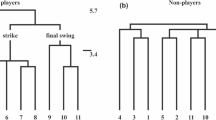Abstract
Age-related characteristics of the formation and development of neurodynamic properties were studied in 835 subjects (6–75 years old) using unified methods and equipment. The dynamics of the growth of these functions and their gradual reduction were determined. Relationship between the properties of the basic nervous processes and temporal parameters of motor responses of various complexity is shown.
Similar content being viewed by others
REFERENCES
Boiko, E.I., Vremya reaktsii cheloveka (Response Time in Humans), Moscow: Meditsina, 1964.
Troshikhin, V.A., Moldavskaya, S.I., and Kol'chenko, N.V., Funktsional'naya podvizhnost’ nervnykh protsessov i professional'nyi otbor (Functional Flexibility of Neural Processes and Occupational Selection), Kiev: Naukova Dumka, 1978.
Loskutova, T.D., Assessment of the Functional State of Human CNS using Parameters of Simple Motor Response, Fiziol. Zh. SSSR im. I.M. Sechenova, 1975, vol. 61, no. 1, p. 3.
Khil'chenko, A.E. and Shevko, G.N., Relationship between the Latency of Simple Motor Reflexes and Flexibility of Basic Nervous Processes in Human Cortex, Fiziol. Zh. SSSR im. I.M. Sechenova, 1964, vol. 10, no. 5, p. 574.
Netopina, S.A., Characteristics of the Properties of Basic Nervous Processes of Schoolchildren in Relation to Their Age and Sex, Gig. Sanit., 1988, no. 6, p. 16.
Teplov, B.M., New Data on the Study of the Properties of Nervous System in Humans, Tipologicheskie osobennosti VND cheloveka (Typological Properties of Human Higher Nervous Activity), Moscow: Akad. Ped. Nauk, 1963.
Nebylitsin, V.D., Osnovnye svoistva nervnoi sistemy cheloveka (The Basic Properties of Human Nervous System), Moscow: Prosveshchenie, 1966.
Rusalov, V.M., Natural Prerequisites of Individual Behavior as a Factor of Human Individuality, Zh. Vyssh. Nervn. Deyat. im. I.P. Pavlova, 1989, vol. 39, no. 3, p. 403.
Makarenko, N.V., Psikhofiziologicheskie funktsii cheloveka i operatorskii trud (Psychophysiological Functions of Humans and the Operator Work), Kiev: Naukova Dumka, 1991.
Makarenko, N.V., Sirotskii, V.V., and Troshikhin, V.A., Methods for Assessment of Basic Properties of Human Higher Nervous Activity, Neirobionika i problemy bioelektricheskogo upravleniya (Neurobionics and Bioelectric Control), Kiev, 1975.
Farber, D.A. and Beteleva, T.G., Structural-Functional Organization of Sensory Maintenance of Cognitive Activity in the Children Ontogeny, Printsipy i mekhanizmy deyatel'nosti mozga cheloveka, Tezisy 2 Vsesoyuznoi konferentsii (Principles and Mechanisms of Human Brain, Abstracts of the Second All-Union Conference), Leningrad: Nauka, 1989, p. 183.
Farber, D.A. and Dubrovinskaya, N.V., Functional Organization of the Developing Brain (Age Characteristics and Some Patterns), Fiziol. Chel., 1991, vol. 17, no. 5, p. 17.
Navakatikyan, A.O. and Kryzhanovskaya, V.V., Vozrastnaya rabotosposobnost’ lits umstvennogo truda (Age-Related Efficiency in Subjects with Mental Work), Kiev: Zdorov'ya, 1979.
Farber, D.A., Kornienko, I.A., and Son'kin, V.D., Fiziologiya shkol'nika (Physiology of Schoolchildren), Moscow: Pedagogika, 1990.
Niedemeyer, E. and Lopez de Silva, F., Electroencephalography. Basic Principles, Clinical Applications and Related Fields, Baltimore: Williams and Wilkins, 1993.
Makarenko, N.V., Time of Complex Sensorimotor Choice Response in Subjects with Various Functional Flexibility of Nervous Processes, Zh. Vyssh. Nervn. Deyat. im. I.P. Pavlova, 1989, vol. 39, no. 5, p. 813.
Makarenko, N.V. and Boreiko, T.I., Formation of Neurodynamic Functions in Children of Early School Age, Fiziol. Zh., 1994, vol. 40, no. 5-6, p. 23.
Gazeev, A.A., Relationships between Latencies and Parameters of Motor Phase of the Response in Various Conditions of Simple Motor Response, Abstract of Cand. Sci. (Psychol.) Dissertation, Moscow, 1983.
Malyarenko, T.N., Gavrilov, V.I., Krasnyanskii, A.N., and Balashov, B.V., Neurodynamics in Human Ontogeny, Sravnitel'naya fiziologiya VND cheloveka i zhivotnykh. Vserossiiskaya konferentsiya, posvyashchennaya 80-letiyu so dnya rozhdeniya chl.-korr. AN and APN SSSR L.G. Voronina (Comparative Physiology of Higher Nervous Activity of Humans and Animals. Russian Conference Devoted to the 80 Anniversary of Corresponding Member of Ross. Acad. Sci. and Ross. Acad. Pedagog. Sci. L.G. Voronin), Moscow, 1988, p. 56.
Boreiko, T.L., Stan vlastivostei osnovnikh nervovikh protsesiv, pam'yati, uvagi, uspishnosti navchannya u ditei molodshogo shkil'nogo viku, Cand. Sci. (Med.) Dissertation, Kiev, 1993.
Davidova, O.M., Stan vlastivostei osnovnikh nervovikh protsesiv, pam'yati ta uvagi v uchniv starshogo shkil'nogo viku, Cand. Sci. (Med.) Dissertation, Kiev, 1996.
Nikonenko, O.P., Zv”yazok vlastivostei osnovnikh nervovikh protsesiv z psikhofiziologichnimi funktsiyami ta z uspishnistyu l'otnogo navchaniya, Cand. Sci. (Med.) Dissertation, Kiev, 1996.
Kharchenko, D.M., Stan psikhofiziologichnikh funktsii u studentiv z riznimi vlastivostyami osnovnikh nervovikh protsesiv, Cand. Sci. (Med.) Dissertation, Kiev, 1998.
Vartseano, M., Activity of Neural Networks in Cognitive Functions, Neirofiziologicheskie mekhanizmy povedeniya (Neurophysiological Mechanisms of Behavior), Moscow: Nauka, 1982, p. 199.
Chang, H.T., The Repetitive Discharges of Cortico-Thalamic Reverberating Circuit, J. Neurophysiol., 1950, vol. 197, p. 551.
Hubel, D.H. and Wiesel, T.N., Shape and Arrangement of Columns in Cat's Striate Cortex, J. Physiol., 1963, vol. 165, p. 559.
Kogan, A.B., Funktsional'naya organizatsiya neironnykh mekhanizmov mozga (The Functional Organization of Neural Brain Mechanisms), Leningrad: Meditsina, 1979.
Kandel, E., Small Neural Systems, Mozg (The Brain), Moscow: Mir, 1982, p. 43.
Livanov, M.N., Prostranstvenno-vremennaya organizatsiya potentsialov i deyatel'nost’ golovnogo mozga. Izbrannye trudy (Spatial-Temporal Organization of the Potential and Activity of the Brain: Collected Works), Moscow: Nauka, 1989.
Mountcastle, V.B., An Organizing Principle for Cerebral Function: The Unit Module and Distributes System, The Neurosciences. IV Study Program, Cambridge: MIT, 1979, p. 21.
Frol'kis, V.V. and Muradyan, Kh.K., Starenie, evolyutsiya i prodlenie zhizni (Aging, Evolution and Lifetime Enhancement), Kiev: Naukova Dumka, 1982.
Author information
Authors and Affiliations
Rights and permissions
About this article
Cite this article
Makarenko, N.V., Lizogub, V.S., Boreiko, T.I. et al. Sensorimotor Functions in Human Ontogeny and Their Relationship with the Properties of the Nervous System. Human Physiology 27, 693–697 (2001). https://doi.org/10.1023/A:1012929110809
Issue Date:
DOI: https://doi.org/10.1023/A:1012929110809




